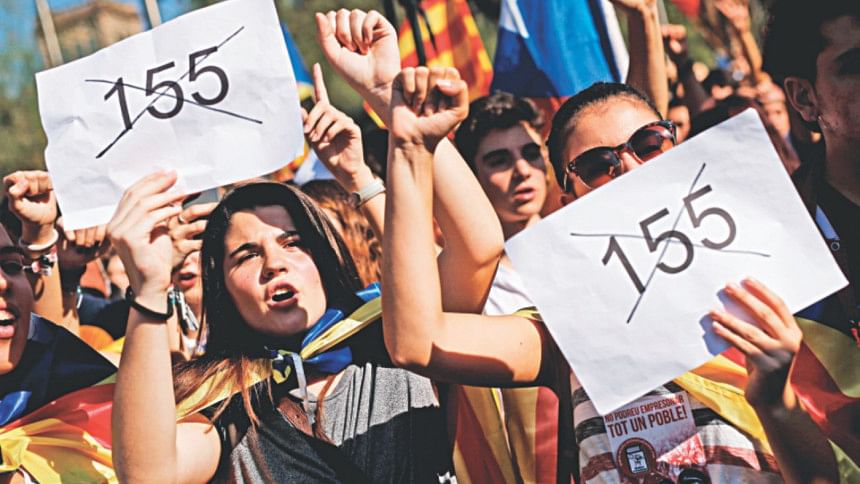Catalonia's struggle for independence

1060: Ramon Berenguer I, the Count of Barcelona, establishes the Usatges de Barcelona, a set of fundamental laws and basic rights of Catalonia. Legally they were only applied in the county of Barcelona, but in practice they took effect throughout the principality of Catalonia.
1283: King Peter III of Aragon sets up the Corts Catalanes. It is a parliament or legislative council for Catalonia.
1469: Catalonia is integrated into kingdom of Spain, created by the marriage of Ferdinand II of Aragon and Queen Isabella of Castile. The union sees the duo merge their respective kingdoms. Before, Catalonia was in the Kingdom of Aragon and had some self-rule. While it becomes part of Spain it keeps its traditional institutions and works as an autonomous state-within-a-state.
1640: Catalonia has its first and only independence war. It happens when the region rebels against the taxation policies of Philip IV of Spain. Catalonia is briefly declared a republic, under French protection.
1651: After a long siege in Barcelona, Catalans accept the rule of the King Philip IV, who later recognises 'privileges' for the region.
1659: The Treaty of the Pyrenees ends a 30 year war between France and Spain and results in the split of Catalonia, which loses the regions of Roussillon, Conflent, Vallespir and part of Cerdanya. The agreement was settled between Castile and France, without input from the Catalan authorities.
1714: King Philip V takes Barcelona after a year-long siege at the end of the War of Spanish Succession. Catalan support for Philip's rival sees its parliament and traditional liberties suppressed after the battle is finished. Two very important Catalan symbols emerged from the era. Rafael Casanova who resisted the siege and the commemoration of the day of the defeat, September 11, which is now marked as Catalonia's national day or Diada.
1812: Catalonia becomes a French region under the rule of Napoleon.
1814: King Ferdinand VII later takes Catalonia back, expelling the “afrancesados”, the Spanish who were in favour of French rule.
1931: Spain becomes a republic and the Generalitat de Catalunya, an autonomous Catalan regional government is created. A year later the first statute of autonomy for Catalonia was drafted.
1938/39: Franco's forces overrun Catalonia and resistance to him collapses elsewhere in Spain. Companys flees to France but is later executed by the Spanish regime. During Franco's dictatorship, which lasts until 1975, Catalan autonomy, language and culture is suppressed.
1979: Four years after Franco's death, Catalonia's modern self-rule is set in motion with the approval of the statute of autonomy.
2006: Catalonia's statute of autonomy is controversially reformed, giving the regional government greater powers. This – and the fact four years later Spain's constitutional court struck down part of the reforms – is widely considered at the heart of today's troubles.
2012: One-and-a-half million people take part in Catalonia's annual national day rally in Barcelona amid growing anger at the amount of money the region pays into Madrid's coffers.
2014: More than 80 percent of those taking part back independence in a non-binding referendum.
2015: Separatist parties win regional elections called to gauge support for a possible declaration of independence.
2017: Artur Mas, a former Catalan leader, is banned from public office for two years for organising the
2014 referendum. In October the region goes ahead with a referendum on independence despite fierce resistance from Madrid.
October, 2017: Catalan parliament declares independence.

 For all latest news, follow The Daily Star's Google News channel.
For all latest news, follow The Daily Star's Google News channel. 



Comments